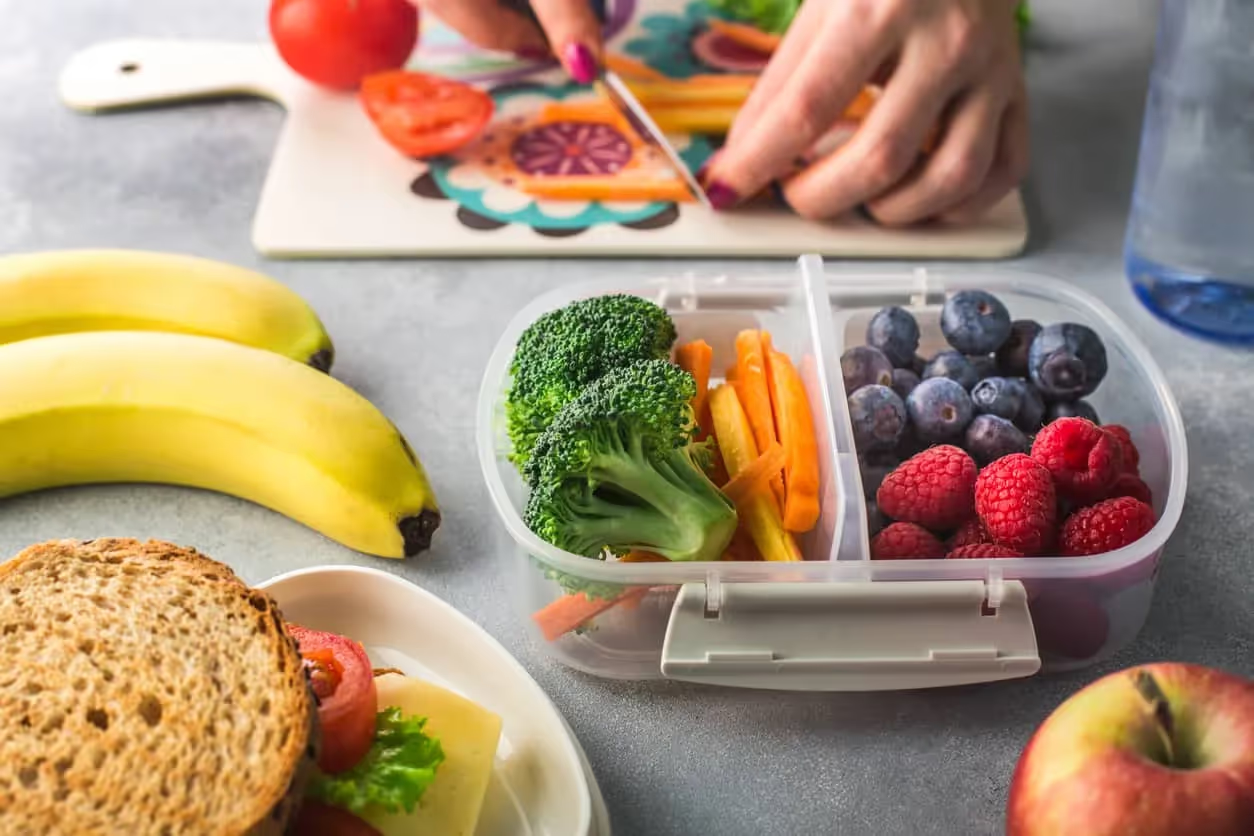Key Takeaways
- The autoimmune protocol (AIP) diet claims to reduce inflammation and symptoms in people with autoimmune conditions.
- It involves an elimination diet, followed by a reintroduction phase and a maintenance phase.
- More research is needed to develop a standardized AIP diet and determine its effectiveness.
If you’ve been following the autoimmune protocol (AIP) diet, you may wonder when and how to start reintroducing foods.
The elimination phase of the diet is highly restrictive and isn’t meant to be followed long-term.
The reintroduction phase of the AIP can last several months and involves adding foods back one by one to determine which foods trigger symptoms.
Continue reading to learn everything you need to know about AIP reintroduction.
{{splash}}
What is the Autoimmune Protocol?
The autoimmune protocol (AIP) is a diet aimed at reducing inflammation in people with autoimmune conditions.
The diet claims to lower systemic inflammation and improve various symptoms related to autoimmune diseases by eliminating potentially inflammatory foods such as eggs, dairy, and grains.
Several small studies have shown the AIP diet may benefit specific autoimmune conditions, like inflammatory bowel disease (IBD) and Hashimoto's thyroiditis.
However, there isn’t a standardized protocol for following the diet, and randomized controlled trials with large sample sizes are necessary to understand how AIP impacts these conditions and other autoimmune diseases.
Talk with your doctor about whether the autoimmune protocol is a good fit for you.
What are the Phases of the Autoimmune Protocol?
Like other elimination diets, the autoimmune protocol has three phases:
- Elimination phase.
- Reintroduction phase.
- Maintenance phase.
Because there is no standardized protocol for the AIP, several variations exist.
For support on following the diet safely and effectively, consult with a dietitian specializing in autoimmune conditions.
Elimination Phase
The first step of the AIP is a strict elimination diet.
This is meant to be a short-term elimination, typically lasting around six weeks.
During this phase, you’ll eliminate the following foods from your diet:
- Grains.
- Legumes.
- Dairy.
- Eggs.
- Nuts and seeds.
- Nightshade vegetables (such as potatoes, tomatoes, peppers, and eggplant).
- Coffee and alcohol.
- Refined sugars and oils.
- Food additives and preservatives.
Some people eliminate these foods all at once, while others work on eliminating them over several weeks.
Once you’ve eliminated all of the foods on the list, it’s recommended to maintain this diet for at least one month.
{{rd-cta}}
Reintroduction Phase
Next is the reintroduction phase, where you’ll “challenge” each food group individually to determine which foods you react negatively to.
Most people don’t react negatively to all of the foods on the elimination list, which means they’ll be able to reintroduce several items back into their diet.
Maintenance Phase
After you’ve learned which foods trigger your symptoms during the reintroduction phase, you shift into the maintenance phase, which will be your long-term eating pattern.
For example, if you try eating nuts and seeds during reintroduction and find they don’t trigger symptoms, you can add them back to your diet.
If you try eating dairy during reintroduction and it does trigger symptoms, you will continue to avoid it long-term.
When Should You Reintroduce Foods on AIP?
Typically, with elimination diets, the reintroduction phase starts once you see a significant improvement or resolution of symptoms related to your condition.
Research shows this is generally after at least four to six weeks of being on the full elimination diet.
Common symptoms of autoimmune conditions include:
- Joint or muscle pain.
- Skin rash.
- Fatigue.
- Digestive symptoms, like diarrhea, constipation, upset stomach, or acid reflux.
Work with your doctor and dietitian to monitor your symptoms and determine when you should start the reintroduction phase of the AIP.
How to Reintroduce Foods on AIP
The reintroduction phase of the AIP has not been well researched.
Most of the studies on the AIP diet to date have focused on the elimination phase and have not followed the participants through reintroduction.
With elimination diets, foods are typically challenged one at a time during the reintroduction phase.
This allows the person to monitor symptoms and identify which specific foods may be contributing.
Depending on the protocol, each food group is reintroduced across a span of three to seven days, starting with very small portions and slowly increasing the volume.
For example, when reintroducing grains, you might start with a few bites of rice on day one, ¼ cup on day two, and ½ cup on day three. During this time, it’s important to monitor your symptoms to identify possible flare-ups.
If you don’t have symptoms, you can reintroduce the food back into your diet.
AIP Reintroduction Stages
The reintroduction stage of the AIP diet ranks foods from lowest to highest risk to determine the order of reintroduction.
The foods least likely to cause a reaction are introduced first, and those with higher risk are introduced last.
There are four stages to AIP reintroduction, but remember these may vary based on the plan you’re following.
The AIP diet isn’t standardized, meaning several variations of the reintroduction stage exist, and these have not been extensively researched.
Stage 1: Reintroducing AIP Foods with Minimal Potential for Flare-Ups
During stage one, you’ll reintroduce the following foods one at a time:
- Egg yolks.
- Seed oils.
- Ghee (clarified butter).
- Legumes with edible pods (green beans, peas, sugar snap peas).
- Cocoa and chocolate.
- Spices including peppercorn.
- Coffee (on an occasional basis).
If you have a known allergy or intolerance to foods from any of the stages, you’ll skip that reintroduction.
Stage 2: Reintroducing AIP Foods with a Greater Potential for Flare-Ups
After reintroducing all of the foods from stage one, you’ll move on to stage two foods:
Some of the foods build up across the stages.
For example, if you tolerate coffee on an occasional basis in stage one, you can enjoy it daily during stage two.
However, if you don’t tolerate coffee during stage one, you won’t rechallenge it in stage two.
Stage 3: Reintroducing More Challenging AIP Foods
Stage three includes the reintroduction of the following foods:
- Limited nightshade vegetables, including eggplant, paprika, and peeled potatoes.
- Dairy products, such as cheese, milk, and yogurt.
- Legumes including lentils, split peas, and garbanzo beans.
Stage 4: Reintroducing AIP Foods With Highest Potential for Reaction
The final stage reintroduces the remaining foods from the elimination diet:
- Remaining nightshade vegetables, including tomatoes, unpeeled potatoes, and peppers.
- Gluten-free grains, such as corn, quinoa, rice, and oats.
- Remaining legumes, including black beans, kidney beans, pinto beans, and peanuts.
- Alcohol (in moderation).
How Long Does Reintroduction Take?
The length of the reintroduction stage depends on how much time you decide to spend on each food category.
If you spend seven days per food group, the reintroduction phase could last around four to five months.
It’s essential to work closely with your doctor and dietitian during this phase for guidance.
The end goal is to find the least restrictive eating pattern that works for your symptoms.
{{Local}}
How to Track Your Reintroductions
It’s important to track your reintroductions to have a clear record of what you tried and the results.
The best way to do this is to keep a food and symptom log.
This will track important details like what you ate, how much, which symptoms you experienced (if any), and the severity of your symptoms.
Signs of an Unsuccessful Reintroduction
If you reintroduce a food and experience a flare-up of symptoms, that tells you the reintroduction was unsuccessful, and you should continue avoiding that food.
For example, if you have inflammatory bowel disease (IBD) and experience abdominal pain or diarrhea after reintroducing dairy, you’ll want to keep dairy out of your diet in the long term.
What Successful Reintroduction Looks Like
Most people aren’t sensitive to all of the foods on the AIP elimination list, so adding several categories back into your diet will likely be part of your long-term plan.
If you reintroduce a food by increasing portions over several days and experience no symptoms, you can put that food back into your diet.
Takeaway
The autoimmune protocol is a diet with three phases: elimination, reintroduction, and maintenance.
The reintroduction phase aims to identify your individual food triggers and learn which foods you can safely include in your diet long-term.
You’ll do this by reintroducing the eliminated food categories one at a time and observing for symptoms.
Remember that the AIP diet, especially the reintroduction protocol, has not been extensively studied.
Work with your doctor to determine whether the AIP diet is right for you.
How a Dietitian Can Help
Working with a dietitian before, during, and after following the AIP protocol can help you maximize the diet's potential benefits.
Your dietitian (along with your doctor) can help you determine if the AIP diet is right for you based on your medical history and the available research.
Because the AIP elimination phase is highly restrictive, your dietitian can help you create a nutritionally balanced meal plan to follow during this period.
Your dietitian can also guide you on when and how to reintroduce foods back into your diet, including tips on keeping a food and symptom log.
Find a dietitian specializing in autoimmune conditions for support with the AIP elimination and reintroduction phases.
Do you have any of these insurances?
Why Join Nourish's RD Network






Frequently Asked Questions
You must meet two criteria to begin the reintroduction phase of the autoimmune protocol (AIP):
- Follow the strict AIP elimination diet for at least four to six weeks.
- Experience an improvement or resolution of autoimmune-related symptoms.
During the reintroduction phase, you will “challenge” foods one at a time to determine which ones may trigger your symptoms.
If a food causes symptoms, you will continue avoiding it, but if you don’t observe any symptoms, you can add it back into your diet.
Most autoimmune protocol (AIP) plans recommend four stages of reintroduction, which include foods ranging from least likely to most likely to cause symptoms.
You can add back dairy in steps across phases one, two, and three of reintroduction:
- Stage One: Ghee.
- Stage Two: Butter.
- Stage Three: Other dairy products (like cheese, milk, and yogurt).
The autoimmune protocol (AIP) has four stages of reintroduction.
Stage one includes foods least likely to trigger a response, and stage four consists of higher-risk foods.
You can reintroduce most spices during stage one of reintroduction, including:
- Allspice.
- Star anise.
- Caraway.
- Cardamom.
- Juniper.
- Peppercorn.
- Sumac.
- Coriander.
- Cumin.
- Dill.
- Fennel.
- Mustard.
- Nutmeg.
You can add paprika during stage three. Cayenne pepper and chili pepper are reintroduced during stage four.







































